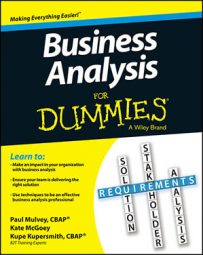The communication tool or method you choose should be appropriate for the audience, content, purpose, and message giver of the communication (as a business analyst, you may create communications for others to deliver). When evaluating communication tools, consider the following:
Number of people involved: What works well for 10 people may not work well for 80.
Type of info to be shared: Are you sharing verbal or visual information? If it’s visual, do you share text, illustration, photos, or video? Some tools are better suited for visuals than others.
Amount or volume of info being communicated: A few paragraphs of information may need 20 minutes and a different communication method than a 40-page document requiring 2 hours.
Frequency of exchange: Consider “why,” “how often,” and “for what purpose?” Depending on your need, the solution may be a weekly team meeting, team members communicating project information three times a day, or a sponsor giving quarterly updates to solution users.
Desire/need for discussion or response: Your approach may differ if communications need to be two-way/back-and-forth versus one-way outbound, such as for announcements or content broadcast.
Sensitivity of the message and expected audience reaction: You may need to take privacy and security into account:
Privacy needs: Sometimes people react unexpectedly when hearing about organizational impacts of solutions, so think about how best to deliver messages so people hear them as intended. Consider whether it makes sense for group members to connect individually (personal reactions held more privately) or as a group (reactions are more public and experienced with the group).
Sensitive topics may be best discussed in real-time instead of being sent over e-mail to be read alone and interpreted. Set up individual calls or a conference. For larger groups, use a conference call or video/web conference, followed by an e-mail to emphasize key message points.
Security needs: How sensitive is the message? Implement information protection methods where appropriate. If privacy is required but conversation or conferencing isn’t possible, be sure to use security encryption on e-mail.
Also consider document settings that disallow printing or forwarding of materials. If you’re using phone or web conference, disable settings that allow participants to initiate or save recordings of the session.
Need for live communication: Phone or conferencing tools are good choices for situations where information and reactions are discussed immediately. If topics need review or thoughtful consideration before discussion, use a delayed or off-line approach. For instance, send information ahead for prereading, but discuss it later in a different communications setting.
Interest in recording or reviewing communications later: Sometimes getting everyone you need together at one time is impossible. If you want to ensure everyone hears the same information, consider recording the session and sharing it in an encore performance.

